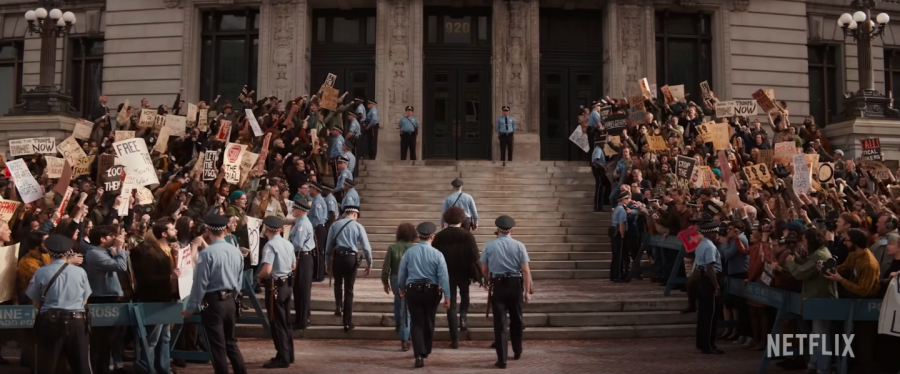Past meets present in ‘The Trial of the Chicago 7’
Police escort one of the Seven to the courthouse, surrounded by protesters. The movie ‘The Trial of the Chicago Seven’ highlights parallels between the 1960s and the present.
From hosting a worldwide pandemic to being an extremely influential election year, it’s needless to say that 2020 has witnessed numerous historical events. A time period with comparable turmoil was the 1960s. The movie “The Trial of the Chicago 7” was released on Friday, September 25, roughly 50 years after the real-life trial of the Chicago 7 took place on September 24, 1969.
Even though the trial took place half a century ago, the events shown looked eerily similar to what we see today.
During the ’60s there were significant civil rights movements, political assassinations and anti-war sentiment. The Vietnam War brought upon a relentless draft and ruthless casualties, making it unpopular, especially among the younger generations.
The film introduces the audience to eight social activists who had their eyes set on change and wanted to bring their own respected group to meet in Chicago, Ill. They intended to organize a peaceful protest of the war at the location the 1968 Democratic National Convention was being held. Plans of a peaceful protest evaporated as the police got involved, and the eight men were soon charged with crossing state lines to incite riots. Their time in court takes up a large portion of the movie, alternating between flashbacks and the trial itself.
The film was full of impactful scenes, including when one of the defendants, National Chairman of the Black Panther Party Bobby Seale, is dragged out of the courtroom for his outbursts. The film creates a sharp contrast by cutting between Seale, forcefully being manhandled into a chair in a separate room, and the court dead silent, waiting for him to return. In this scene, the emphasis was not only on people’s reactions, but the sound of a man’s voice being silenced compared to the silence of others. Seale was later removed from the trial: Eight defendants dropped to seven.
The movie makes it clear that Seale’s inhumane treatment was the result of racial discrimination. During the trial, a handful of other men interrupted or spoke out of turn, but none of them were gagged or tied down. But none of them were Black. Seale’s treatment frustrates me, but as I reflect on the state of our country in 2020, I am disappointed in the lack of progress I see.
Another particularly poignant moment in the film is when the police throw tear gas at a crowd of protesters at a nearby park, then beat them with their batons. While the screams and blood of actors make this scene heartwrenching, the film drives the point home by cutting to real footage from the actual event. In this manner, the movie emphasizes the realness of this event. People were harmed by government officials for standing up for what they believed in.
The movie and footage as a whole reminded me of similar videos — videos we’ve seen circulating the internet for months. Look no further than Portland, Ore., where tear gas made another appearance as a weapon used against protesters by the police. Or handheld video footage from bystanders who witness police brutality firsthand, whether it’s at protests or their own neighborhood.
The Seven are charged guilty, however, but before they are sentenced, the judge allows the defendants to make a statement to the court. The only restrictions were that it should be respectful, remorseful and brief. One of the defendants and social activist, Tom Hayden, speaks for the group. He starts by announcing over 4,000 troops had been killed in Vietnam since the trial started, then proceeds to read their names. I am particularly fond of this moment for the film circles back to what the social activists are fighting for, whether or not they are convicted guilty by the court.
Just over two hours long, the movie may seem like another history documentary, but the issues it addresses are as relevant as ever, making this movie an influential force and a reminder to the work we have left to do.




